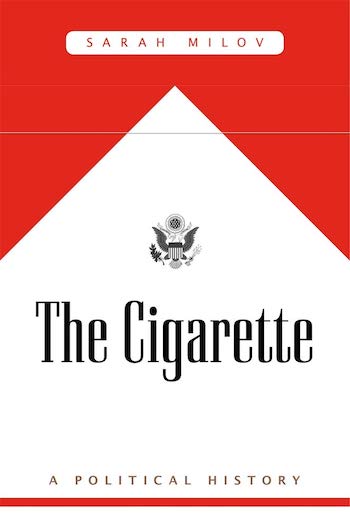“The Cigarette: A Political History”
by Sarah Milov

The Cigarette: A Political History
by Sarah Milov
400 pp., Cambridge: Harvard University Press, 2019.
Reviewed by Ed Lengel
Nostalgia, as Sarah Milov reminds us in the introduction to The Cigarette: A Political History, sometimes fails to account for certain grim—in this case, smelly and smoky—realities. Not so long ago, almost half of adult Americans smoked, and often heavily. In homes, schools, offices, grocery stores, airplanes, buses—all the way to the Oval Office—cigarette smoke polluted the air. Nicotine-addicted smokers—including the same glamorous celebrities who defined “cool” for generations—ruined their hearts and lungs. They also made life miserable for nonsmokers, who often had nowhere to go where they could breathe freely.
Why did this happen? And how did it end? Popular accounts—the 1999s movie, The Insider–for example–which showed Russell Crowe and Al Pacino working to expose the tobacco industry’s conspiracy to spike cigarettes with extra nicotine to keep smokers addicted—presented the story simply as a case of corporate greed run rampant. But Milov, an assistant professor of history at the University of Virginia, offers a far more complex consideration of the cigarette phenomenon in the twentieth century. In her scholarly–and periodically dry–analysis, the heroes and villains are real enough, but perhaps not so easily defined.
In the early twentieth century, tobacco growers in states like North Carolina stood in thrall to cigarette manufacturers, who purchased leaf via an engineered auction system that locked in low prices, despite growing public demand. During World War I, the government connived in marketing cigarettes directly to soldiers and workers—the burgeoning global popularity of American flue-cured tobacco, and changing social mores, especially among women, opened access to millions of new smokers. Manufacturers profited enormously, but growers, many of them small-scale and African American, struggled to stay above the poverty line because of overproduction and low prices.
President Franklin D. Roosevelt’s New Deal addressed this and other agricultural problems by introducing subsidies that guaranteed higher prices, while mandating cuts in tobacco cultivation and production. This, and especially the worldwide boom in smoking during and after World War II, established a golden era for growers and manufacturers; it also gave federal and state governments a direct stake in promoting tobacco consumption—in other words–convincing more people to smoke. The best markets in the postwar period were abroad, and so the U.S. government, working through the Marshall Plan, provided subsidies for European cigarette manufacturers to purchase American tobacco. Trade agreements and promotions soon spread the habit around the world.
By the 1950s and 1960s cigarettes were ubiquitous. Advertisements permeated television, radio, print media, and billboards. A surgeon general’s report of 1964 formalized what a growing number of doctors had been saying for years: cigarettes caused cancer, and other ailments. The manufacturer-boosted Tobacco Industry Research Committee, founded in 1953, nevertheless worked with significant success to instill doubt in the public by insisting that “not all doctors agreed,” or that the surgeon general’s findings were “controversial.” Because of that campaign of manipulation, smoking rates declined only gradually.
The battle lines were not evenly drawn. As Milov explains, the U.S. government remained firm in its support of tobacco, while Congress stonewalled efforts to restrict consumption. Warning labels on packaging, and restrictions on advertising, were adopted only with agonizing slowness. The movers and shakers in the fight against Big Tobacco were not public-minded government officials, but grassroots organizers and aggressive (and sometimes self-serving) lawyers like John Banzhaf, and crusading consumer advocates like Ralph Nader. Banzhaf’s late 1960s efforts –in –moved local efforts by crusading lawyers to “sue the bastards” as the best means of finding and prying open chinks in Big Tobacco’s armor to establish new regulations against smoking in public places.
Milov’s chronicle of the creation of a concept nonsmokers’ rights produces some of The Cigarette’s most fascinating passages. Small town heroes abound, such as Bell Telephone employee Donna Shimp—who had to wear a gasmask just to get through the days in her smoky office, eventually decided to sue, and in winning, established a legal precedent for ensuring nonsmokers’ right to clean air. Just as often, though, grassroots efforts failed. Success in suppressing public smoking came about only after decades of effort, and primarily on the municipal level, with cities and towns establishing laws against smoking where states and the Federal government refused. Ultimately, it was the efforts of public health organizations to prove the economic costs of smoking associated with medical care and workplace delinquency that convinced thousands of businesses across the country to voluntarily restrict workplace smoking. Eventually, overall rates of smoking declined, rapidly.
It was not until the 1980s and 1990s, that antismoking crusades really turned a corner—in part from the work of Surgeon General C. Everett Koop, who spoke hopefully of creating a nonsmoking America by the year 2000. In Congress too, Big Tobacco’s power was beginning to crumble, because of bipartisan collaboration that would have been unthinkable in years past, as small-government Republicans and public health-oriented and anti-corporate Democrats worked together to limit– and then end– government subsidies of tobacco. The real losers, though, as Milov shows, were not the cigarette manufacturers, who reaped big profits as they found new sources of cheap tobacco and markets abroad, but American growers, who– by the 1990s—were driven back into the poverty from which New Deal subsidies had rescued them. Estimates suggest that antismoking efforts have saved approximately eight million American lives—so far–but has smoking really gone away, or, as Milov surmises, just been driven into to the margins?
Ed Lengel is the Chief Historian at the National Medal of Honor Museum; Arlington, Texas




